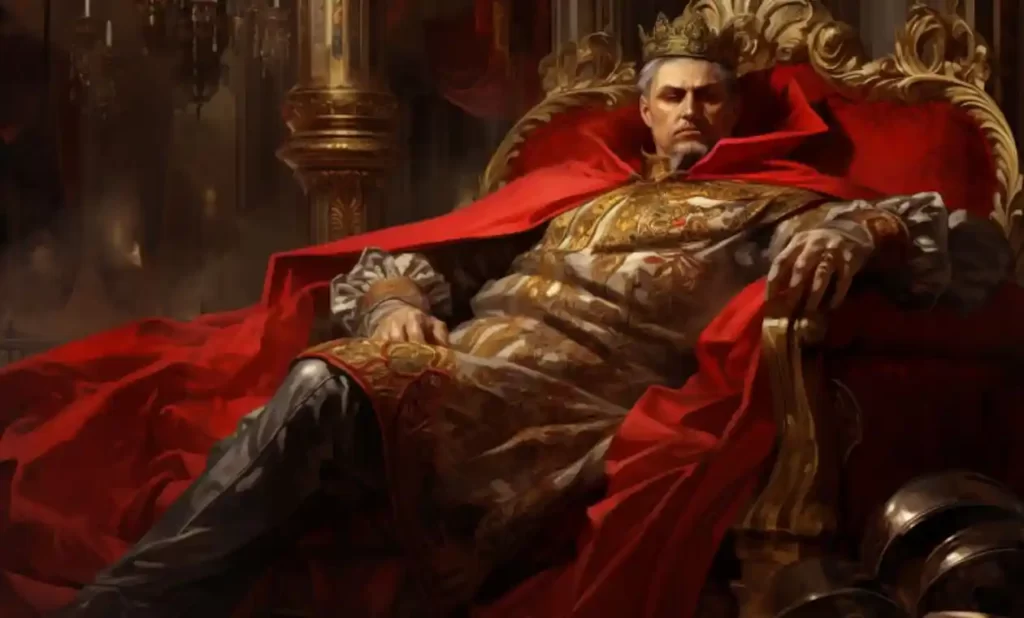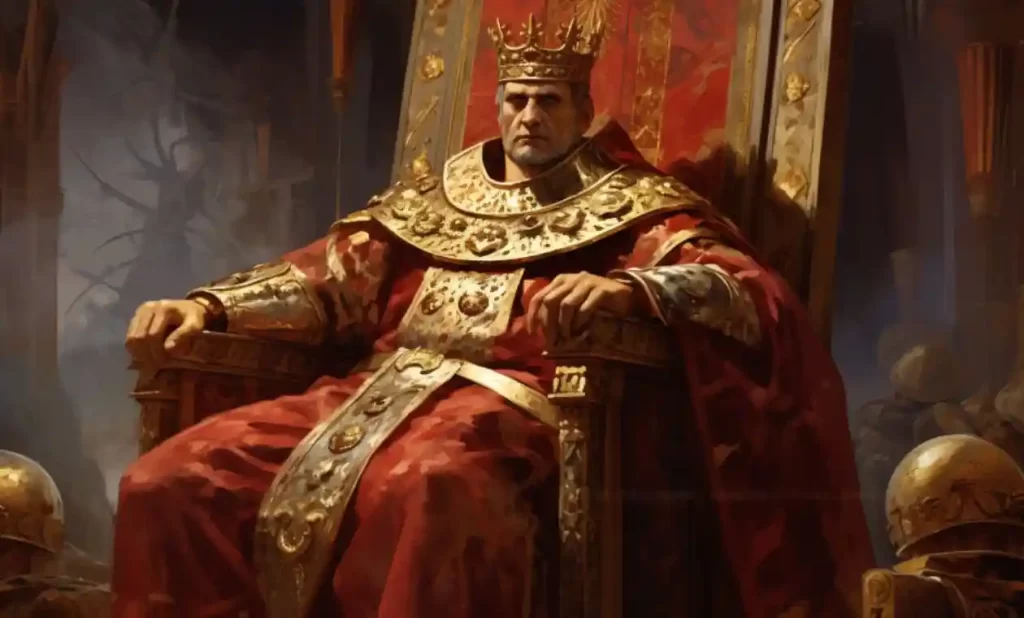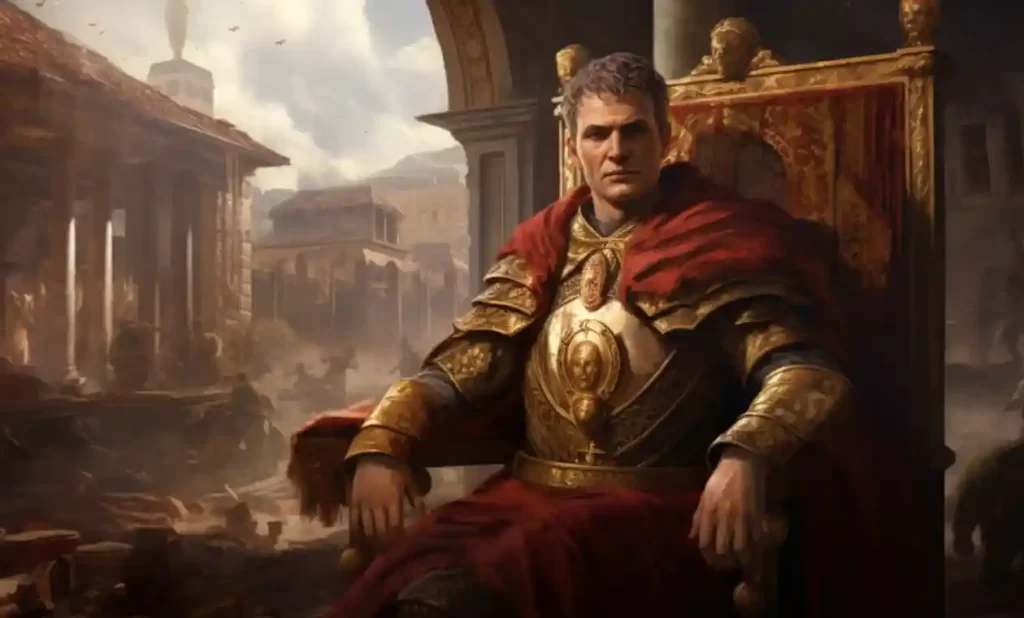
Emperor Galerius, a pivotal figure in the annals of Roman history, emerged during a time of significant transition and challenges. Born in the late 3rd century, Galerius’ early life was marked by a meteoric rise through the military ranks, eventually leading him to the corridors of power in the Roman Empire.
As the 20th Emperor, Galerius assumed the throne during the tumultuous period of the late Roman Empire. His reign, which began in 305 AD, unfolded against a backdrop of political instability and external threats. Galerius played a crucial role in the Tetrarchy, a cooperative ruling arrangement alongside fellow emperors Diocletian and Maximian. This division of power aimed to address the vastness of the empire and its diverse challenges.
Galerius’ leadership was characterized by a strong military presence, marked by successful campaigns against external foes. His policies, though at times controversial, sought to maintain order and stability in a rapidly changing empire. Furthermore, his reign witnessed significant developments in administrative structures and economic policies.
In this article, we delve into the life and times of Emperor Galerius, exploring the intricate tapestry of his rule, examining key achievements, and shedding light on the historical context that shaped his legacy. Join us on a journey through the corridors of power in ancient Rome as we unravel the enigmatic tale of Emperor Galerius.
Personal Details of Emperor Galerius
| Aspect | Details |
| Full Name | Gaius Galerius Valerius Maximianus |
| Birth Date | Around 260 AD |
| Birthplace | Dacia (modern-day Serbia or Croatia) |
| Family Background | Born to a humble family, possibly a herdsman’s son |
| Early Life | With limited historical information, early life shrouded in mystery |
| Personal Writings | No significant personal writings or detailed accounts |
| Death Date | May 5, 311 AD |
| Death Circumstances | Unclear, with conflicting accounts (possibly due to illness or suicide) |
| Successor | Maximinus Daia, chosen as Caesar |
Early Life and Rise to Power
Background and Early Life of Galerius

Emperor Galerius, originally named Gaius Galerius Valerius Maximianus, was born around 260 AD in a humble family in the province of Dacia, part of the Roman Empire. Little is known about his early life, shrouding his origins in mystery. Some historical accounts suggest his father might have been a simple herdsman.
Galerius’ ascent to power defied the conventional paths of the Roman nobility. His early years were spent in relative obscurity, and it was through his exceptional military prowess that he began to attract attention. This rise from humble beginnings to the pinnacle of Roman authority would later characterize his remarkable journey.
Entry into the Military and Rise Through the Ranks
Galerius’ journey to prominence commenced when he joined the Roman military. His talents on the battlefield quickly distinguished him, earning him recognition and promotions. Galerius displayed a strategic acumen that set him apart, and his military achievements caught the eye of the reigning Emperor Diocletian.
As he ascended through the military hierarchy, Galerius gained a reputation for both his loyalty and ruthlessness. His role in quelling internal dissent and defending the empire’s borders solidified his standing within the military and positioned him as a key figure in the Roman power structure.
Connection with Diocletian and the Tetrarchy
Galerius’ pivotal connection came in the form of Diocletian, the reigning emperor. Recognizing Galerius’ military prowess, Diocletian appointed him as Caesar in 293 AD, a title signifying the heir apparent. This marked the inception of the Tetrarchy, a system of co-rule involving two Augusti (Diocletian and Maximian) and their designated Caesars (Constantius Chlorus and Galerius).
Galerius’ association with Diocletian and the Tetrarchy not only defined his political trajectory but also played a crucial role in shaping the course of the Roman Empire. Together, they sought to address the challenges of governance in an empire stretching from Britannia to Persia.
Reign and Achievements
Galerius assumed the role of Roman Emperor in 305 AD, following the abdication of Diocletian. His reign unfolded in a period of significant challenges and transitions for the Roman Empire. Galerius faced the daunting task of maintaining order and stability in an empire marked by internal strife and external threats.
Like Augustus, Galerius adopted a robust and assertive leadership style. His reign was characterized by a strong emphasis on military might, reflecting the turbulent times in which he ruled. Under his command, the Roman legions engaged in key military campaigns aimed at securing the empire’s frontiers and asserting dominance over rival powers.
Key Military Campaigns and Victories
Galerius’ military campaigns were marked by both successes and challenges. Notably, he led campaigns against the Sassanian Empire in the east, securing victories that solidified Roman influence in the region. His efforts in defending the Danubian frontier against barbarian invasions further showcased his military acumen.
One of the significant military achievements during Galerius’ reign was the defeat of the usurper Domitius Alexander in 308 AD, solidifying his grip on power. However, the challenges of maintaining control over a vast and diverse empire persisted, and Galerius faced continued threats from both internal dissension and external adversaries.
Administrative and Economic Policies During His Rule
Galerius implemented several administrative and economic policies aimed at strengthening the Roman Empire. Understanding the need for effective governance, he continued the administrative reforms initiated by Diocletian. These reforms included the division of the empire into smaller administrative units to improve efficiency and governance.
Economically, Galerius faced the daunting task of stabilizing an empire grappling with inflation and economic challenges. In response, he introduced the Edict on Maximum Prices in 301 AD, an attempt to curb inflation by setting price controls on various goods and services. While the edict had short-term effects, it highlighted the economic complexities of the time.
Galerius’ reign, though marked by military successes, also reflected the ongoing challenges of governance in a vast and diverse empire. In the next section, we explore his relationship with Diocletian and his role in the Tetrarchy system.
Relationship with Diocletian
Examination of Galerius’ Partnership with Diocletian
Galerius’ partnership with Diocletian played a crucial role in shaping the political landscape of the Roman Empire. Diocletian, as the senior Augustus, recognized Galerius’ military prowess and leadership capabilities, leading to the appointment of Galerius as Caesar in 293 AD. This appointment marked the beginning of a collaborative rule that would become known as the Tetrarchy.
Galerius’ relationship with Diocletian was multifaceted, combining elements of mentorship and strategic alliance. While Diocletian maintained his position as the senior Augustus, Galerius emerged as a trusted lieutenant, actively participating in key military and administrative decisions. This partnership provided a degree of stability during a period of internal and external challenges.
Role in the Tetrarchy System
The Tetrarchy system, initiated by Diocletian, divided the Roman Empire’s rule among two Augusti and two Caesars, creating a framework for shared governance. Galerius, as Caesar, shared the eastern half of the empire with Diocletian. This system was designed to address the vastness of the empire and its intricate challenges, allowing for more efficient administration and defense.
Galerius’ role in the Tetrarchy extended beyond a mere co-ruler. His military expertise and assertive leadership were instrumental in defending the empire’s borders and suppressing internal dissent. The collaborative effort between Diocletian and Galerius showcased a dynamic approach to governance, albeit one that would undergo challenges as power dynamics evolved.
Handling of the Roman Empire During Joint Rule

As a participant in the Tetrarchy, Galerius played a vital role in the overall management of the Roman Empire. Together with Diocletian, he faced the complexities of ruling an expansive territory, grappling with issues ranging from military defense to economic stability. The Tetrarchy system aimed to distribute responsibilities effectively, allowing each ruler to focus on specific regions and challenges.
Galerius’ influence was particularly pronounced in the eastern regions of the empire, where his military campaigns and administrative decisions left a lasting impact. However, the collaborative rule faced internal tensions and power struggles, foreshadowing the eventual decline of the Tetrarchy system.
Persecution of Christians
Galerius’ policies towards Christians during his reign reflected a period of significant tension between the Roman authorities and the growing Christian community. While Diocletian initiated the series of edicts against Christians, Galerius intensified the persecution, particularly in the eastern part of the empire.
In 303 AD, Galerius issued the infamous “Edict of Serdica” (also known as the Edict of Toleration), which aimed at suppressing Christianity. This edict mandated the destruction of Christian churches, the burning of Christian scriptures, and the imprisonment of Christian clergy. It was a calculated effort to eradicate Christianity from the fabric of the Roman Empire.
Religious Dynamics During His Reign
The religious dynamics during Galerius’ reign were marked by a clash between traditional Roman beliefs and the rise of Christianity. Galerius, adhering to the traditional Roman pantheon, viewed Christianity as a threat to the stability of the empire. The Christian refusal to participate in state-sanctioned religious ceremonies and their perceived allegiance to a higher authority fueled suspicions among the Roman authorities.
Galerius’ policies were driven not only by religious concerns but also by a desire for political unity. The perceived insubordination of Christians was seen as a challenge to the traditional Roman social order and the emperor’s authority.
Impact on the Christian Community
The impact of Galerius’ persecution on the Christian community was profound. Christians faced persecution on multiple fronts – their places of worship were destroyed, sacred texts were confiscated and burned, and many endured imprisonment and torture. The aim was to suppress the growth of Christianity by eliminating its institutions and influential figures.
Despite the harsh measures, the Christian community persevered. The resilience displayed by Christians during this period contributed to the eventual shift in Roman policy towards Christianity. Galerius’ successor, Constantine the Great, would later issue the Edict of Milan in 313 AD, granting religious tolerance to Christians and ending the era of systematic persecution.
Legacy and Historical Significance
Assessment of Galerius’ Contributions to the Roman Empire
Galerius, despite the controversies surrounding his reign, made notable contributions to the Roman Empire. His military campaigns secured the frontiers, pushing back external threats and maintaining territorial integrity. Galerius’ administrative reforms, especially in the eastern regions, aimed to streamline governance and enhance the efficiency of imperial rule.
However, his legacy is also intertwined with the intense persecution of Christians. The Edict of Serdica left a dark mark on his rule, impacting the lives of countless Christians and shaping the religious landscape of the empire for years to come.
Lasting Impact on Politics, Military, and Culture
Galerius’ impact on politics, military affairs, and culture was significant, albeit complex. In politics, his role in the Tetrarchy system showcased a collaborative approach to rule, attempting to address the challenges posed by the vastness of the Roman Empire. The Tetrarchy left a lasting impact on the imperial structure, influencing subsequent reforms.
Militarily, Galerius’ campaigns defended the empire’s borders, demonstrating the necessity of a strong military presence during a period of external threats. His successes and challenges in this realm shaped subsequent military strategies employed by later emperors.
In terms of culture, Galerius’ reign is often overshadowed by the religious tensions and persecution of Christians. The suppression of Christianity had a profound impact on the cultural dynamics of the time, creating a rift that persisted even after the eventual acceptance of Christianity within the empire.
Legacy Compared to Other Emperors of the Time
Compared to other emperors of his era, Galerius’ legacy is complex and multifaceted. While he shared power with Diocletian in the Tetrarchy, his rule faced internal challenges and power struggles. His aggressive policies towards Christians set him apart, marking a stark contrast with the more tolerant stance of some contemporaries.
In the grand tapestry of Roman history, Galerius is often seen as a transitional figure, navigating an empire in flux. His legacy is one of both military accomplishment and religious intolerance, making him a subject of historical analysis and debate.
Personal Life and End of Reign
Details about Galerius’ Personal Life
Galerius, despite his significant historical role, remains a figure with much of his personal life shrouded in mystery. Historical records provide limited insights into his early years, family, and personal preferences. His humble origins as the son of a herdsman underscored the unconventional nature of his rise to power.
In contrast to some of his contemporaries, Galerius did not leave behind a wealth of personal writings or detailed accounts of his private life. This lack of personal documentation leaves historians to speculate about his personality, relationships, and daily life.
Events Leading to the End of His Reign
The latter years of Galerius’ reign were marked by challenges, both internal and external. As a co-ruler in the Tetrarchy, power struggles among the emperors and conflicts over succession plans strained the political fabric of the empire. The death of both Diocletian and Maximian in 311 AD left Galerius as the senior Augustus.
Facing threats from rival claimants, including Constantine the Great, Galerius attempted to consolidate power. However, the internal strife and external pressures placed a heavy burden on his rule. His attempts to stabilize the empire and manage succession ultimately proved challenging, contributing to the decline of the Tetrarchy system.
Death and Aftermath
Galerius’ reign came to an end with his death on May 5, 311 AD. The circumstances surrounding his death remain unclear, with conflicting historical accounts. Some sources suggest that Galerius succumbed to a painful illness, possibly a form of cancer, in Nicomedia. Others propose that he may have taken his own life to escape the agony of his ailment.
Upon his death, Galerius was succeeded by his chosen Caesar, Maximinus Daia, although the stability of the empire continued to deteriorate. The demise of the Tetrarchy marked a period of further turbulence, eventually leading to the rise of Constantine the Great, who would reunite the Roman Empire under a single ruler.
Galerius’ death and the subsequent events marked the end of an era and set the stage for the transformative changes that would unfold in the Roman Empire during the years to come.
Conclusion
Emperor Galerius, a complex and enigmatic figure in Roman history, rose from humble beginnings to wield significant influence during a pivotal era. His military successes, administrative reforms, and role in the Tetrarchy highlighted his contributions to the Roman Empire. However, Galerius’ legacy is marred by his harsh persecution of Christians, a policy that left an indelible mark on the religious landscape.
Galerius navigated a diverse empire during times of political and social upheaval, attempting to secure stability amid internal strife. His death in 311 AD marked the end of a challenging reign, contributing to the unraveling of the Tetrarchy. While his rule left a lasting impact on the Roman Empire’s administrative structure and military strategies, it is his religious policies that often defined his historical significance.
In reflection, Emperor Galerius remains a symbol of the complexities inherent in the governance of a vast and diverse empire. His life and rule serve as a lens through which historians explore the delicate balance between political power, military might, and the cultural dynamics that shaped the course of Roman history during a transformative period.



